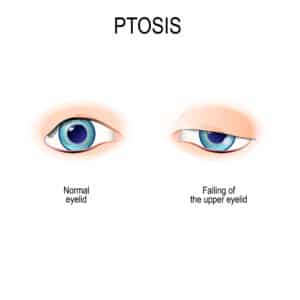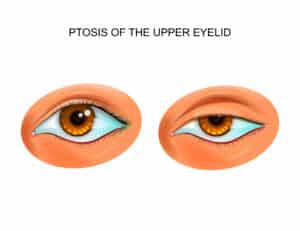Eyelids protect your eyes from dust and debris. They also distribute lubrication and nutrients that keep your eyes healthy.
Ptosis is a condition that can negatively affect your upper eyelids and reduce your ability to see. Keep reading for some insight into what ptosis is and treatment options to consider!
Ptosis 101

Ptosis is a condition that occurs and makes the upper eyelid droop. It may happen in one or both eyes.
This sagging happens when the levator muscle in the upper eyelid is damaged or weakens. The muscle fibers attach to the tarsal plate at the levator aponeurosis.
The tarsal plate is a thick series of connective tissues that support the eyelid. These parts work together to lift and adjust the upper eyelid.
People who are born with ptosis have what’s known as congenital ptosis. If left untreated, congenital ptosis can prevent a child’s vision from developing as the optical nerves decline.
You may get ptosis as an adult, called acquired ptosis. This condition usually develops over many years. Often, there are minimal symptoms until the eyelid droop is significant and becomes more noticeable.
Ptosis can make you look older than you are. In severe cases, it can limit your sight. Some adults and many children tilt their heads back to lift their eyelids and improve their field of vision. This adjustment can cause problems like neck and back pain.
Ptosis may be a sign of issues with the brain, nerves, or muscles. This type of ptosis often develops quickly, over several hours or days. Immediately call an eye doctor if you are experiencing sudden-onset eyelid drooping or sagging.
Severe ptosis may cause lazy eye or astigmatism due to extreme muscle imbalance. Symptoms of this condition include impaired vision and excessively rubbing your eyes. You could have ptosis if your eyes are frequently teary or blurry, but blinking helps.
What Causes Ptosis?
Aging is a common cause of this condition. As you grow older, your skin and muscles weaken and lose elasticity. These factors combine with gravity to impair eyelid function.
Physical trauma that damages the levator muscle or aponeurosis can also spur ptosis. Severing or rupturing the muscles can occur in a sports injury or accident.
You may have mechanical ptosis if you have a mass or tumor on the eyelid that pulls on the muscles. Being overweight could also contribute as excessive eyelid weight can cause sagging.
Neurogenic ptosis happens if the nerves that manipulate your eyelids have a problem. Horner syndrome, third nerve palsy, and myasthenia gravis can cause this condition.
Chronic muscle disorders like muscular dystrophy or progressive external ophthalmoplegia can cause myogenic ptosis. This issue happens when the levator muscle weakens.
How Is Ptosis Diagnosed?
An eye doctor will diagnose ptosis by assessing the eyelid. They’ll perform a regular eye exam to learn your visual acuity.
After getting a better understanding of your visual acuity, they will determine how much your eyelid is drooping. Your eye doctor does this by measuring the distance from the middle of the pupil to the edge of the upper eyelid.

They will lightly hold onto the frontalis muscle, located in the forehead, and ask you to look in different directions. They will then request that you open and close your eyes. These tests will show the strength of your levator muscle.
Your eye doctor will also ask about your medical history. Be sure to mention if you have any recent physical trauma and any family history with ptosis. If they suspect an underlying issue, they may send you to a neurologist or to see your primary care doctor.
It’s important to rule out additional health problems before treating ptosis. Addressing other health concerns may reduce ptosis symptoms.
What Are Treatment Options For Ptosis?
Most ptosis requires outpatient surgery—minor ptosis benefits from removing some eyelid tissue to reduce droopiness. If you have a mass, taking out the accumulated cells may reduce the weight. It may be enough to return the eyelid to its normal function by taking out these accumulated cells.
Extreme versions of the condition require surgery to shorten the levator muscle. Some people have their aponeurosis reattached to the tarsal plate to improve eyelid control. Surgery can correct the drooping but may not be able to make the lids perfectly symmetrical.

Some medications can also strengthen the eyelid muscles over time. Your eye doctor may recommend a Botox injection to stiffen the upper eyelid.
Children diagnosed with ptosis might not be candidates for surgery as the condition may go away as they grow and get older. Some require surgery to avoid the development of lazy eye due to muscle imbalances.
How Can I Prevent Myself From Developing Ptosis?
Congenital ptosis is not preventable, as it may be genetic. Talk with your eye doctor if you have immediate family members with this condition. This factor may increase your likelihood of developing ptosis.

Reduce your chances of suffering an eye injury that causes ptosis by wearing proper eye protection whenever possible. Wear goggles while working with chemicals. Use safety glasses or a face shield when working with metals, wood, and cement. Wear a helmet with a face cage during sports and wear a seatbelt in the car.
Takle Eye Group can improve your vision and quality of life. Our passionate eye care team has over 40 years of experience providing eye exams and treating various conditions.
Call to schedule an appointment at Takle Eye Group in Griffin, GA today to find out how to treat your ptosis and get back to feeling and looking your best!




